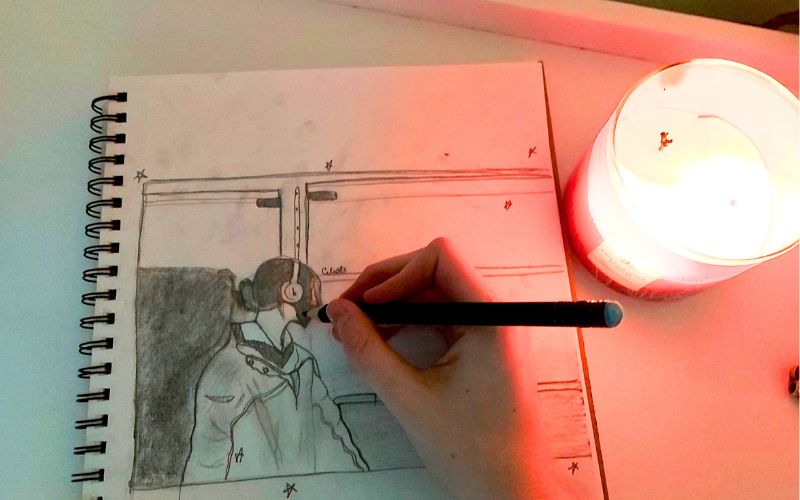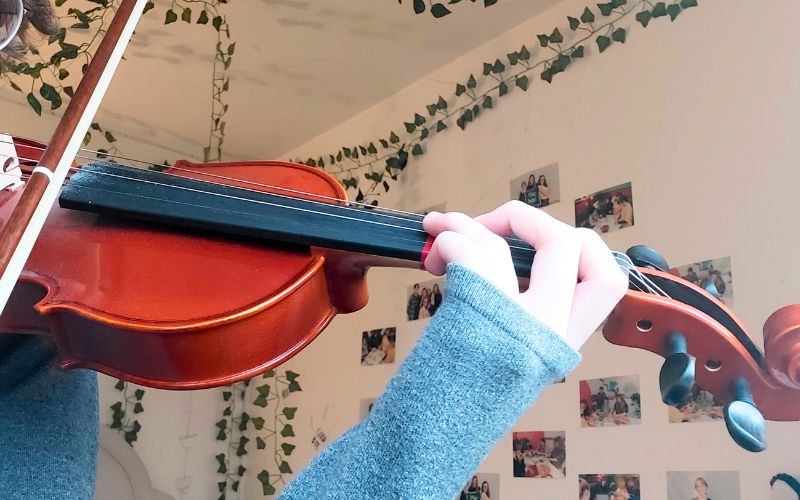Celeste has spent her entire schooling journey to date with SelfDesign® Learning Community, beginning in 2012, when she started grade one. Her parents had learned about our kindergarten to grade 12 program when she was a toddler and thought it would be a better option for her than public school.
“I honestly love it so much,” says Celeste, whose main passions right now are crocheting, playing violin and drawing. “SelfDesign has always been a really supportive community, and I’m looking forward to future learning with them.”
 The Nanaimo-based learner transitioned to grade 10 last year and has taken the increased responsibility for her own learning that is part of the higher grades at SelfDesign in stride. For her first grade 10 personal project, she focused on drawing, telling us she enjoyed documenting her improvement throughout the winter break. She also made her first online learning portfolio to document and showcase her learning.
The Nanaimo-based learner transitioned to grade 10 last year and has taken the increased responsibility for her own learning that is part of the higher grades at SelfDesign in stride. For her first grade 10 personal project, she focused on drawing, telling us she enjoyed documenting her improvement throughout the winter break. She also made her first online learning portfolio to document and showcase her learning.
“I like the real-time meetings such as Open Spaces, the collaborative theme meetings with other teens, and the weekly challenges. I also enjoy the Learning Experiences Library a lot because it has lots of resources about art, music and literature,” she says. “I was especially inspired looking at all the SelfDesign learner showcases in January! I’ve also recently picked up crocheting because I saw someone in SelfDesign mention they liked it, which sparked my interest.”
Another new experience for Celeste in grade 10 was the in-person provincial numeracy assessment, which she participated in at a SelfDesign-hosted session in Nanaimo. It was her first test-like experience in her 10 years with SelfDesign.
B.C.’s provincial grade 10 and 12 assessments
In British Columbia, every young person seeking to finish grade 12 with a Dogwood Diploma is required to write the BC Ministry of Education and Child Care’s Grade 10 Numeracy Assessment, Grade 10 Literacy Assessment, and Grade 12 Literacy Assessment.
“The BC Ministry assessments are not tests,” says SelfDesign Guidance Team Coordinator Ruby Payne. “The results don’t affect marks, and they’re not tied to any specific courses. However, they are requirements for the B.C. graduation program – learners are required to take them if they want to finish high school with a Dogwood Diploma. That basically means learners just need to try their best.”
Because they’re supervised, B.C.’s grade 10 and 12 assessments are held in person. To give all our learners who seek a Dogwood Diploma the opportunity to take the assessments and meet the graduation requirements, our Guidance team arranges SelfDesign invigilation sessions for high population density areas around the province, collaborates with brick-and-mortar schools in communities around B.C. to find placements for our learners, and in a few communities where those options are not available, the team arranges spaces within the community, with SelfDesign contractors supervising the assessment events.
Learners who have little experience with writing “tests” or being formally assessed or haven’t spent much time inside brick-and-mortar schools sometimes find the thought of provincial assessments stressful.
“I was a bit caught off guard when I first learned about it,” Celeste says. “I was somewhat expecting that I would have to take assessments, but to actually hear it for the first time was a bit unsettling for me. I’ve adjusted to the idea, however, and all I want to do moving forward is to get prepared.”
Preparing learners for provincial assessments
The educators who support our grade 10 to 12 learners work with them to prepare for the assessments. The educators explain how the assessments work. They guide the learners through the general material that will be covered. They may suggest practice assessments that learners can work on and direct learners to resources, including those on the SelfDesign Learning Experiences Library, that may help them to prepare.
For example, the learning specialist who facilitated one of the themes Celeste had chosen to explore in Grade 10 guided her and her peers through what they might expect during the Grade 10 Numeracy Assessment and through the kinds of information, knowledge and math skills they should pay attention to as they prepared.
In addition, Celeste says, “My learning consultant talked with me about the rules, guidelines, and so on.”
She says, “Everyone was very helpful and calm throughout the preparation.”
Learners can also access materials through our Family Services’ Virtual Brochure Rack to help themselves prepare mentally for the experience. Our Family Services team has assembled resources to help learners and families navigate, for example, anxiety and stress, and develop mindfulness, relaxation and goal-setting skills.
The assessment environment
In addition to ensuring learners have opportunities to take the assessments and meet their graduation requirements, SelfDesign’s Guidance Team works to make sure the physical spaces where our learners take the assessments are friendly and welcoming.
“We like to be able to have a warm and welcoming SelfDesign face at the door,” Ruby says. “We put vases of flowers out on the desk and write welcome signs — little things that can help to bring that anxiety down a bit and that can make a real difference in terms of the atmosphere of a room.”
At the SelfDesign-hosted session, Celeste attended for the Grade 10 Numeracy Assessment last year, battery chargers for learners’ mobile devices and a table with snacks were also provided.
The assessment experience
Despite all the preparation, for many of our learners, the assessments can still cause some anxiety.
“For some of our learners, heading into an in-person educational experience that is an assessment — and we tend to associate assessments with tests — can be difficult,” Ruby says.
Celeste says of her own experience with the Grade 10 Numeracy Assessment, “As you would during a test (and my first in-person one at that), I was very nervous. The leaders were very supportive and the environment wasn’t stressful in any way, but I still felt that bit of anxiety — which I think is completely normal during a test, but I tried to remember to breathe and do my best.”
Sometimes a learner may be the only young person taking an assessment in that location. Other learners may find themselves among several SelfDesign learners taking the assessment at that time and in that place. Or they may be one of a number of students from the brick-and-mortar school hosting the assessment. It all depends, Ruby says, on how many SelfDesign learners in an area are scheduled to take that assessment that year and what placements for taking the assessments the Guidance Team can arrange for them.
Celeste was one of approximately 13 other teens taking the Grade 10 Numeracy assessment in Nanaimo last fall.
“They all seemed nervous like me, but a part of that made me feel a little better — knowing I wasn’t the only one feeling doubtful,” she says. “It was cool being in a learning environment with other kids my age as well. I even met some of my friends from SelfDesign whom I’d only talked to on Zoom!”
Overall, she felt the assessment went well. “It wasn’t as stressful as I had made it out to be, and everyone there was calm and patient,” she says. “Personally, if I were to do it over again, I would just prepare myself a bit more beforehand in terms of Math knowledge, but I tried my best and now I know what I should work more on in the long run.
Her advice for other SelfDesign learners who are facing their first-grade 10 or 12 provincial assessments is: “Don’t overthink it too much. It’s normal to feel nervous and doubt yourself, but it’s really not as bad as it seems beforehand.”
What’s next for Celeste?
“I have so many ideas of what I want my life to look like in five or more years, but I know I really want to pursue music in some way,” Celeste says. “I’m a violinist, and learning the instrument has become a very big part of my life over the last couple of months. I have dedicated more and more time to improving and learning more about this skill.
“Later on, whether it be getting extra credits in university or even becoming a music teacher farther down the road, I want it to be a part of my life for a while.”
Although she has time before she has to decide, she’s considering what she’ll do when her SelfDesign journey ends — whether she’ll take a gap year, travel, or when she might start college or university.
In the meantime, her more immediate goal is to be more diligent with her schoolwork.
“I’ve noticed that through my high school years so far, I want to be more productive and get more things done,” she says.
Read more about how SelfDesign supports learners in preparing for provincial assessments
Learn more about SelfDesign’s Guidance Centre
Learn more about paths to completion at SelfDesign Learning Community
Learn more about grades 10 to 12 at SelfDesign Learning Community
Read advice our learners in grades 10 to 12 have shared with their peers







